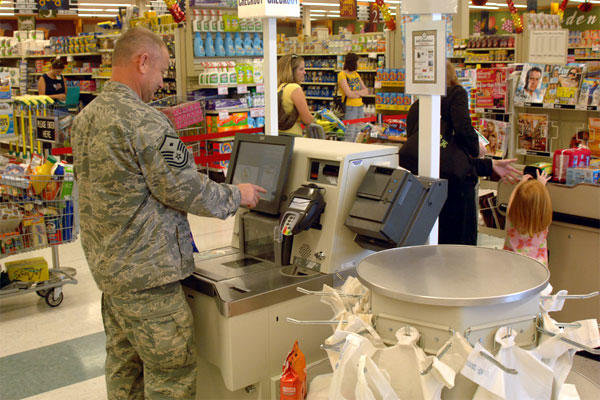The Department of Defense is modifying its approach to reform the commissary benefit with new guarantees to preserve overall shopper savings and also to avoid pay cuts for current employees, according to a source who has seen fiscal 2017 budget planning documents.
The guarantees are part of a revised commissary overhaul proposal that officials believe Congress, shopper advocates and store suppliers will view far more favorably than the department’s push the past two years to slash funding of base grocery stores and, in effect, hope the benefit survives.
Senior defense officials and some military leaders still want to see most taxpayer support of the Defense Commissary Agency (DeCA) phased out so that the $1.4 billion annual budget can be shifted to higher readiness-related priorities. The long-term goal remains to turn commissaries into self-sustaining “non-appropriated fund” activities like military exchanges.
Exchange services operate for-profit department stores on base as well as food courts, specialty shops, gas stations and franchises, all of which make profits that fund base morale, welfare and recreational (MWR) activities such as golf courses, gymnasiums, movie theaters and libraries.
The puzzle has been how to operate commissaries profitably and still preserve the deeper discounts they provide, which DeCA claims save shoppers an average of 30 percent compared to grocery prices off base.
Lawmakers, particularly in the House, have made clear they want those savings preserved. So part of the revised reform plan, which would test variable pricing to generate profits, would include benchmarks to track and protect some baseline level of savings. If profits aren’t realized as planned, DeCA still could draw on appropriated dollars to keep store prices sufficiently low to preserve customer savings targets.
The revised plan also would stipulate that no commissary employee would suffer a pay reduction while stores are converted to non-appropriated fund (NAF) activities. Exchanges and other NAF operations typically set wages below the General Schedule pay scale used by commissaries. Lower pay rates help to ensure exchange service profitability.
Another part of the new approach to commissary reform would be to narrow significantly the planned cuts to the commissary appropriation. For fiscal 2016, the administration had proposed cutting DeCA’s budget by $322 million, or 23 percent, followed by $1 billion or 70 percent in 2017.
The new plan would cut DeCA’s budget by only $8 million in both 2017 and 2018, $191 million in 2019, $358 million in 2020 and $512 million in 2021. Defense officials apparently have accepted criticism that the slope of their earlier cost cutting would have decimated the shopping benefit.
By slowing funding cuts so they don’t outpace promised efficiencies, shopper savings would be protected, said a resale industry expert who expressed relief over proposal changes. He noted the department’s earlier plan to cut DeCA funding by $1 billion gave “no justification” for doing so.
“So anything that narrows that would be better,” he said.
The new reform package also seems to heed warnings from exchange executives that deep cuts to commissary discounts will sharply reduce customer traffic in base exchanges, lowering those profits needed to support on-base MWR activities.
The proposal still would seek new authorities to change how commissary products are priced and sold. Current law requires that goods be sold at cost plus five percent surcharge. Surcharge dollars are used to modernize old stores or build new ones. Otherwise, commissaries depend on tax dollars to operate stores, pay wages and salaries and transport American-made goods to commissaries on U.S. bases overseas.
DoD wants to replace cost-plus-five pricing with commercial pricing practices to generate more revenue and reduce cost of goods sold. It could vary prices based on store location or introduce commissary brand or “private label” products to compete against national brands. Commercial stores see significantly higher profit margins on private label products.
Commissaries also would adopt new incentives to operate stores more efficiently and generate savings. A new “optimization management” board would be established, comprised of resale system business leaders, to oversee reforms and improved business practices.
Defense officials were weighing one significant change to their reform proposal. Rather than test the NAF concept with new pricing schemes on a sampling of 10 stateside stores over two years, the idea now is to apply alternative pricing to 30 percent of all goods stocked in stateside commissaries. If profits result, it would be phased in for all products.
Defense officials were prepared to argue these changes are a budget priority and critical to adopt starting in fiscal 2017. The approach also is backed by a final 291-page report from Boston Consulting Group (BCG), which took months to study ways that DeCA funding could be cut while minimizing any negative impact on commissary shoppers.
The study has been shared with Congress and was to be briefed on Thursday Sept. 17 to the members of House armed services subcommittee on military personnel, which oversees on-base resale operations.
BCG criticizes cost-plus-five pricing as preventing commissaries from capturing profits beyond the surcharge, and creating “an environment of misaligned incentives…in which higher sales volume results in greater losses, increasing the need” for appropriated funds.
It urges adoption of a new business model and legislation to lift a host of operating constraints. It forecasts savings of $420 to $670 million annually “while maintaining or enhancing patron benefit.”
It says up to $165 million could be saved from improved merchandising and reduced cost of products sold, and $120 million from introducing commissary-brand products. Over time, holding down employee pay and benefits to match those of other non-appropriated fund workers could save up to $155 million more per year, BCG reports.
It urges DeCA to use more realistic estimates of shopper savings. BCG found commissary shoppers saved 16 to 21 percent when prices are compared to lowest-price nearby competitors, usually Wal-Mart stores.
To comment, write Military Update, P.O. Box 231111, Centreville, VA, 20120 or email milupdate@aol.com or twitter: @Military_Update




